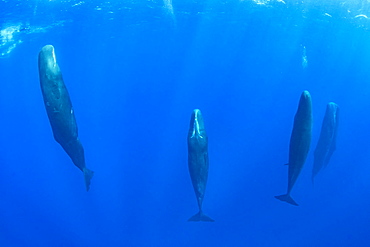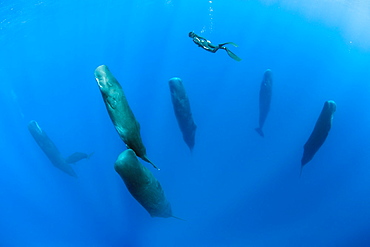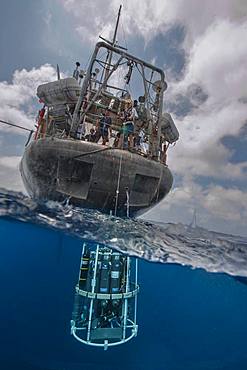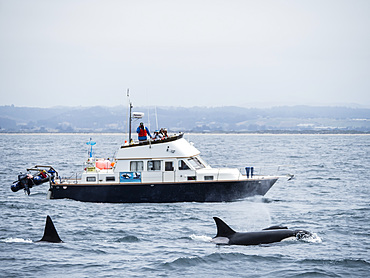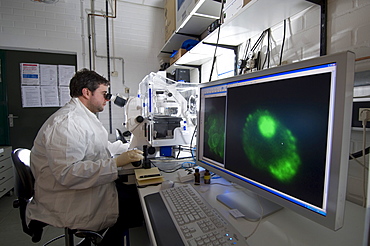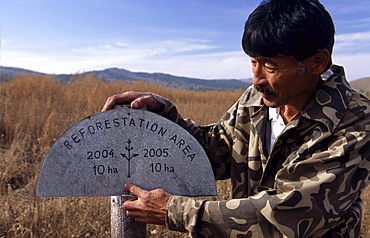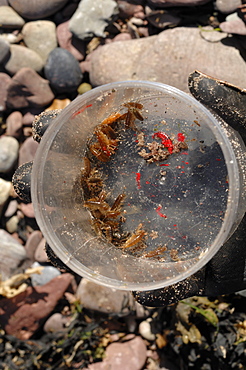Recent searches
Loading...
1112-5676 - Young whale shark (Rhincodon typus), filter feeding near snorkeler at El Mogote, Baja California Sur, Mexico, North America
860-287910 - Pod of Sleeping sperm whale (Physeter macrocephalus) Researchers first saw this unusual sleep behavior in sperm whales in 2008. The scientists in that study found that sperm whales dozed in this upright drifting posture for about 10 to 15 minutes at a time, Vulnerable (IUCN). The sperm whale is the largest of the toothed whales. Sperm whales are known to dive as deep as 1,000 meters in search of squid to eat. Dominica, Caribbean Sea, Atlantic Ocean. Photo taken under permit n°RP 16-02/32 FIS-5.
860-287909 - Pod of sperm whale relaxing after a short sleep (Physeter macrocephalus) Researchers first saw this unusual sleep behavior in sperm whales in 2008. The scientists in that study found that sperm whales dozed in this upright drifting posture for about 10 to 15 minutes at a time, Vulnerable (IUCN). The sperm whale is the largest of the toothed whales. Sperm whales are known to dive as deep as 1,000 meters in search of squid to eat. Dominica, Caribbean Sea, Atlantic Ocean. Photo taken under permit n°RP 16-02/32 FIS-5.
860-287914 - Free diver is swimming over a pod of Sleeping sperm whale (Physeter macrocephalus) Researchers first saw this unusual sleep behavior in sperm whales in 2008. The scientists in that study found that sperm whales dozed in this upright drifting posture for about 10 to 15 minutes at a time, Vulnerable (IUCN). The sperm whale is the largest of the toothed whales. Sperm whales are known to dive as deep as 1,000 meters in search of squid to eat. Dominica, Caribbean Sea, Atlantic Ocean. Photo taken under permit n°RP 16-02/32 FIS-5.
860-287906 - Pod of Sleeping sperm whale (Physeter macrocephalus) Researchers first saw this unusual sleep behavior in sperm whales in 2008. The scientists in that study found that sperm whales dozed in this upright drifting posture for about 10 to 15 minutes at a time, Vulnerable (IUCN). The sperm whale is the largest of the toothed whales. Sperm whales are known to dive as deep as 1,000 meters in search of squid to eat. Dominica, Caribbean Sea, Atlantic Ocean. Photo taken under permit n°RP 16-02/32 FIS-5.
860-287912 - Snorkeler photographing a pod of Sleeping sperm whale (Physeter macrocephalus) Researchers first saw this unusual sleep behavior in sperm whales in 2008. The scientists in that study found that sperm whales dozed in this upright drifting posture for about 10 to 15 minutes at a time, Vulnerable (IUCN). The sperm whale is the largest of the toothed whales. Sperm whales are known to dive as deep as 1,000 meters in search of squid to eat. Dominica, Caribbean Sea, Atlantic Ocean. Photo taken under permit n°RP 16-02/32 FIS-5.
860-287452 - Tara Oceans Expeditions - May 2011. CTD-Rosette (Conductivity Temperature Density instrumental platform with 7 additional sensors)
1112-4206 - Adult killer whales (Orcinus orca) near research boat in the Monterey Bay National Marine Sanctuary, California, United States of America, North America
746-16167 - Researcher is measuring the gas temperature on the crater, CNR volcanology research, Aeolian Islands, Sicily, Italy
1112-2807 - Adult bull Type A killer whale (Orcinus orca) surfacing near researchers in the Gerlache Strait, Antarctica, Polar Regions
1112-2806 - Adult bull Type A killer whale (Orcinus orca) surfacing near researchers in the Gerlache Strait, Antarctica, Polar Regions
1112-2805 - Adult Type A killer whale (Orcinus orca) surfacing near researchers in the Gerlache Strait, Antarctica, Polar Regions
857-86262 - A researcher holds a Barn Owl (Tyto alba) after it was captured from Vancouver International Airport. The bird will be relocated to an area 100km away from the airport in hopes that it will not return, Langley, British Columbia, Canada
832-372193 - Stem cell research, Max Planck Institute for Molecular Genetics, scientist, laboratory technician cultivating stem-cells, Berlin, Germany
832-372194 - Stem cell research, Max Planck Institute for Molecular Genetics, laboratory technician observing nerve cells through a microscope, Berlin, Germany
832-374085 - Neko Harbor, Gerlache strait, Antarctic Peninsula, Antarctica
832-372195 - Stem cell research, Max Planck Institute for Molecular Genetics, laboratory technician observing nerve cells through a microscope, Berlin, Germany
832-355541 - Museum of the famous asia explorer Nikolaj Michailovic Prshevalski, Karakol, Kyrgyzstan
832-355540 - Museum of the famous asia explorer Nikolaj Michailovic Prshevalski, Karakol, Kyrgyzstan
832-355551 - Trail marker of the Lewis and Clark National Historic Trail, Montana, USA
832-321632 - German Roentgen museum at the native town of Roentgen, Remscheid-Lennep, NRW, Germany
832-304556 - The "Ra" at the Kon-Tiki Museum on Bygdoy Peninsula, Oslo, Norway, Scandinavia, Europe
832-296671 - Albert Einstein was born 18 April 1955 in Ulm and died on 14 March 1879 in USA, physicists, Nobel prize winner
832-139367 - Statue of Fridtjof Nansen in front of the Fram, Fram Museum, Oslo, Norway, Europe
832-139379 - The Fram, the research ship of Fridtjof Nansen and Roald Amundsen, Fram Museum, Oslo, Norway, Europe
832-139366 - Statue of Fridtjof Nansen in front of the Fram, Fram Museum, Oslo, Norway, Europe
857-50846 - A water quality researcher samples Toxic Blue Green Algae in the Copco Reservoir in Northern California.
857-32785 - Jennifer Carroll, oyster hatchery manager and researcher at Center of Marine Biotechnology, Baltimore MD.She is holding a diploid Asian oyster C. ariakensis in the "algae kitchen" in the biosecure laboratory. She is studying reproduction to determine whether to introduce into the bay.
857-37193 - Research assistants and technicians from the University of Ghana collect dust samples from the living rooms and bedrooms of children in Accra, Ghana. The samples will be analyzed for the presence of dust mites, fungus', and animal allergens to help researchers better understand why children in wealthier homes have higher rates of allergies and asthma than poorer children. The leading theory is that higher rates of helminth (parasite) infections among poorer children are affecting the immune system in a way that offers protection from allergies and asthma. The study aims to find out what the worms are doing, isolate the beneficial effect and replicate it.
857-37194 - Research assistants and technicians from the University of Ghana collect dust samples from the living rooms and bedrooms of children in Accra, Ghana. The samples will be analyzed for the presence of dust mites, fungus', and animal allergens to help researchers better understand why children in wealthier homes have higher rates of allergies and asthma than poorer children. The leading theory is that higher rates of helminth (parasite) infections among poorer children are affecting the immune system in a way that offers protection from allergies and asthma. The study aims to find out what the worms are doing, isolate the beneficial effect and replicate it.
857-37208 - Research assistants and technicians from the University of Ghana collect dust samples from the living rooms and bedrooms of children in Accra, Ghana. The samples will be analyzed for the presence of dust mites, fungus', and animal allergens to help researchers better understand why children in wealthier homes have higher rates of allergies and asthma than poorer children. The leading theory is that higher rates of helminth (parasite) infections among poorer children are affecting the immune system in a way that offers protection from allergies and asthma. The study aims to find out what the worms are doing, isolate the beneficial effect and replicate it.
971-48 - Leatherback turtle (Dermochelys coriacea) eggs being collected for transfer to a safer hatchery location, Shell Beach, Guyana, South America
1194-2419 - East timor. Examining blood sample to test for malaria, aileu
1196-224 - Gonchigjaviin tsedendash is incharge of mongolian forest research foundation. with a mandate to reforest areas effected by environmental mining degradation
971-47 - Leatherback turtle (Dermochelys coriacea) eggs being collected for transfer to a safer hatchery location, Shell Beach, Guyana, South America
971-42 - Turtle warden with nesting Leatherback turtle (Dermochelys coriacea), Shell Beach, Guyana, South America
971-36 - Researchers measuring a female Leatherback turtle (Dermochelys coriacea) at its nest site, Shell Beach, Guyana, South America
971-37 - Applying a tag to a Leatherback turtle (Dermochelys coriacea) at its nesting site, Shell Beach, Guyana, South America
971-46 - Leatherback turtle (Dermochelys coriacea) laying eggs under the watchful eyes of a conservation worker, Shell Beach, Guyana, South America
939-25 - Humpback Whale (Megaptera novaeangliae) sounding and researchers. Alaska
981-31 - Young hatchling Komodo dragons (Varanus komodoensis), prior to release in the tree canopy - the natural habitat for first 2 - 3 years.
978-440 - Giant Manta at Cleaning station being cleaned by butterfly fish. Pacific Ocean, Ecuador
978-423 - Black Manta birostris with remora. Pacific Ocean, Ecuador
978-425 - Research diver approaching manta birostris to record detail in research program, Project Elasmo. Pacific Ocean, Ecuador
978-422 - Black Manta birostris with remora. Pacific Ocean, Ecuador
978-434 - Green Sea Turtle (Chelonia mydas) near to the surface. Machalilla National Park, Ecuador. Pacific Ocean, Ecuador
978-444 - Giant manta ray, Isla de la Plata Ecuador. Portrait shot of Manta birostris approaching camera. Pacific Ocean, Ecuador
978-430 - Research diver approaching manta birostris to record detail in research program, Project Elasmo. Pacific Ocean, Ecuador
978-441 - Giant manta ray, Isla de la Plata Ecuador. Portrait shot of Manta birostris approaching camera. Pacific Ocean, Ecuador
978-438 - Green Sea Turtle (Chelonia mydas) near to the surface. Machalilla National Park, Ecuador. Pacific Ocean, Ecuador
978-432 - Research diver approaching manta birostris to record detail in research program, Project Elasmo. Pacific Ocean, Ecuador
978-445 - Manta Birostris swimming at surface, Pacific Ocean, Ecuador. Pacific Ocean, Ecuador
978-443 - Manta Birostris swimming at surface, Pacific Ocean, Ecuador. Pacific Ocean, Ecuador
978-442 - Manta Birostris swimming at surface, Pacific Ocean, Ecuador. Pacific Ocean, Ecuador
978-431 - Giant manta ray, Isla de la Plata Ecuador. Portrait shot of Manta birostris approaching camera. Pacific Ocean, Ecuador
978-418 - Research diver approaching manta birostris to record detail in research program, Project Elasmo. Pacific Ocean, Ecuador
978-439 - Green Sea Turtle (Chelonia mydas) and Giant Manta Ray (manta birostris). Pacific Ocean, Ecuador
988-169 - Harbour porpoise (Phocoena phocoena) caught in herring weir (fish trap). Porpoises trapped in herring weirs often die as a result of efforts to remove them (by 'seining' the weir as shown here) but latterly cooperation between fishermen and researchers has improved the situation. Five porpoises were trapped in this weir and none were thought to have survived this operation. Grand Manan, Bay of Fundy, Canada
978-420 - Research diver approaching manta birostris to record detail in research program, Project Elasmo. Pacific Ocean, Ecuador
978-426 - Research diver approaching manta birostris to record detail in research program, Project Elasmo. Pacific Ocean, Ecuador
978-428 - Satellite Tag attached to Giant Manta Ray, Ecuador. The lines to the left indicate recent fishing damage. Pacific Ocean, Ecuador
978-435 - Mobula species Isla de la Plata, Ecuador, Machalilla National Park. Pacific Ocean, Ecuador
978-446 - Giant manta ray, Isla de la Plata Ecuador. Portrait shot of Manta birostris approaching camera. Pacific Ocean, Ecuador
978-447 - Research diver approaching manta birostris to record detail in research program, Project Elasmo. Pacific Ocean, Ecuador
978-429 - Research diver approaching manta birostris to record detail in research program, Project Elasmo. Pacific Ocean, Ecuador
978-419 - Research diver approaching manta birostris to record detail in research program, Project Elasmo. Pacific Ocean, Ecuador
978-433 - Research diver approaching manta birostris to record detail in research program, Project Elasmo. Pacific Ocean, Ecuador
978-427 - Research diver approaching manta birostris to record detail in research program, Project Elasmo. Pacific Ocean, Ecuador
978-424 - Research diver approaching manta birostris to record detail in research program, Project Elasmo. Pacific Ocean, Ecuador
988-168 - Minke whale (Balaenoptera acutorostrata) caught in creel line. Minke whales are occasionally caught in the lines connecting lobster pots (creels) and will drown if not released promptly. This creel fishermen helped researchers untangle this dead whale from another fisherman's gear. Hebrides, Scotland
978-437 - Green Sea Turtle (Chelonia mydas) near to the surface. Machalilla National Park, Ecuador. Pacific Ocean, Ecuador
978-436 - Green Sea Turtle (Chelonia mydas) near to the surface. Machalilla National Park, Ecuador. Pacific Ocean, Ecuador
978-421 - Research diver approaching manta birostris to record detail in research program, Project Elasmo. Pacific Ocean, Ecuador
1036-208 - New Zealand Whale and Dolphin Trust working with Hectors dolphins (Cephalorhynchus hectori) Akaroa, South Island: New Zealand.
1036-207 - New Zealand Whale and Dolphin Trust working with Hector's dolphins (Cephalorhynchus hectori)
1034-19 - orca/ killer whale (Orcinus orca) 'Luna' (L98), 5-year old lone male interacting with people's feet in Nootka Sound, West Vancouver Island, Canada, North Pacific.
915-777 - Whale shark researcher and Whale Shark , Rhincodon typus, Mahe, Seychelles, Indian Ocean
1034-21 - orca/ killer whale (Orcinus orca) 'Luna' (L98), 5-year old lone male interacting with Ed Thornburn in Nootka Sound, West Vancouver Island, Canada, North Pacific.
1034-18 - orca/ killer whale (Orcinus orca) 'Luna' (L98), 5-year old lone male interacting with Ingrid Visser (photo by T. Hardie) in Nootka Sound, West Vancouver Island, Canada, North Pacific.
921-486 - 03/04/2009. São Jorge government sponsored research centre and Botanic Gardens, Botanic Gardens. Praia, Sao Tiago Island. Cape Verde
915-780 - Whale shark researcher snorkelling underwater with Whale Shark
915-761 - Whale shark researcher and Whale Shark , Rhincodon typus, Mahe, Seychelles, Indian Ocean
921-487 - Botanic Gardens, 03/04/2009. São Jorge government sponsored research centre and Botanic Gardens, Women picking strawberries. Praia, Sao Tiago Island. Cape Verde
921-491 - Botanic Gardens, Bourganvilia, 03/04/2009. São Jorge government sponsored research centre. Praia, Sao Tiago Island. Cape Verde
915-584 - A level students doing a sandhopper survey, Castle Bay, Dale, Pembrokeshire, Wales, UK, Europe
915-588 - Sandhoppers in collecting jar, A level students doing a sandhopper survey, Castle Bay, Dale, Pembrokeshire, Wales, UK, Europe
915-775 - Whale Shark , Rhincodon typus, Mahe, Seychelles, Indian Ocean (rr)
915-585 - A level students doing a sandhopper survey, Castle Bay, Dale, Pembrokeshire, Wales, UK, Europe
915-770 - Whale shark researcher and Whale Shark , Rhincodon typus, Mahe, Seychelles, Indian Ocean
915-781 - Whale shark researcher snorkelling underwater with camera, Mahe, Seychelles, Indian Ocean
915-762 - Whale shark researcher and Whale Shark , Rhincodon typus, Mahe, Seychelles, Indian Ocean
931-281 - Blue whale (balaenoptera musculus) A blue whale researcher watches a whale pass by.The Gulf of California.
921-488 - Botanic Gardens, 03/04/2009. São Jorge government sponsored research centre and Botanic Gardens, 4 x 4, strawberry fields. Praia, Sao Tiago Island. Cape Verde
915-589 - A level students doing a sandhopper survey, Castle Bay, Dale, Pembrokeshire, Wales, UK, Europe
915-757 - Whale shark researcher and Whale Shark , Rhincodon typus, Mahe, Seychelles, Indian Ocean
915-774 - Whale shark researcher snorkelling underwater with Whale Shark
921-485 - 03/04/2009. São Jorge government sponsored research centre and Botanic Gardens. Locals carrying hay bails along main road. Praia, São Jorge botanical gardens. , Sao Tiago Island. Cape Verde
915-586 - A level students doing a sandhopper survey, Castle Bay, Dale, Pembrokeshire, Wales, UK, Europe
921-489 - Botanic Gardens, strawberrys, arid soil, 03/04/2009. São Jorge government sponsored research centre. Praia, Sao Tiago Island. Cape Verde

